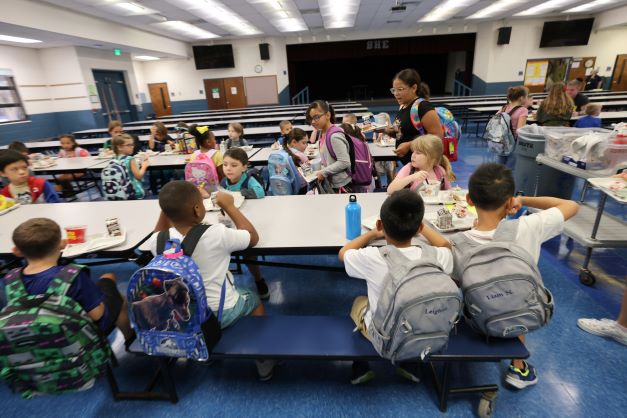Free meals for students in Marion County Public Schools

Students eat their breakfast in the cafeteria on the first day of school at Shady Hill Elementary in Ocala, Fla. on Wednesday, August 10, 2022. [Bruce Ackerman/Ocala Gazette] 2022.
Students across 52 of Marion County’s public schools can now eat breakfast and lunch for free during the 2022-23 school year thanks to the Community Eligibility Provision (CEP) initiative.
Students will be eligible to be fed regardless of family income, and there is no application necessary. The initiative that allows for free meals is funded by the Florida Department of Agriculture and will be provided to the district due to the percentage of students from each school who are participating in at least one public assistance or service program.
“There are no strings attached. The program is an extension of the National School Lunch Program,” said Jamie Lovett, the supervisor of the food and nutrition department. “It provides eligibility for a whole school or a group of schools, and we are reimbursed based on the number of meals that we serve.”
The program will allow for schools to serve free meals to about 43,000 students that the district projects will be enrolled for the upcoming school year. Apart from the 52 schools listed on the MCPS website, only a few schools were either not eligible for the program or opted to continue using their own programs to feed students, said Lovett.
“Ina A. Colen Academy has its own school meals program, and you will need to contact them for more details,” Lovett said. “We are working on CEP approval for Fordham Early Learning Academy and Ocali Charter. Until that happens, these schools will receive meals, so no student goes hungry.”
MCPS students were able to receive free meals for the past two years through waivers from the United States Department of Agriculture (USDA) which operated summer meal programs. With the recent eligibility for CEP, schools must qualify based on the number of directly certified students who are qualified for free meals based on other means than the previous application process, she said.
Schools with around 40% or more of students enrolled in assistance programs are eligible for the initiative, and as of last March about 62% of students in Marion County were directly certified through at least one type of federal assistance program, said Lovett.
Lovett briefed the Marion County School Board on the district’s eligibility for CEP during the most recent administrative work session on August 4. While members of the school board expressed their gratitude that so many students will be able to have free meals without filling out an application, they also expressed concern that such a large percentage of Marion County students have a necessity for assistance.
“It actually shows kind of a reflection on our community,” said School Board Vice-Chair Allison Campbell. “While it’s very positive that our students are able to receive it, the reason they are is because our community has such a significant number of students living in a government assistance, poverty situation financially.”
Board Member Don Browning said he felt that giving students free meals regardless of income could be a slippery slope into students growing up to be dependent on welfare and other government assistance opportunities.
“I think at this juncture it’s incredibly important [in the] broad picture to look at the implications of widespread adaptation of welfare,” Browning said. “Welfare is not a positive view of our society. It’s capitalist. Get out, have a job, maybe work a couple of jobs, and actually provide a lunch and a sandwich, for example, for your children.”
Board Chair Eric Cummings countered this comment by clarifying that the school board was in no way encouraging people to be subsidized or rely on government aid. Cummings expressed his gratitude that the students who do not have access to ample food will now have the opportunity to receive free or reduced-price lunch without needing to go through an application process.
“We’re not glamorizing poverty. We’re not glamorizing anything other than the fact that our kids will be able to [eat]. All of our kids will have the opportunity,” Cummings said. “The fact still remains that there is a large segment of our community that needs these resources.”
School Board Attorney Jeremy Powers offered clarification in response to comments from Campbell and Browning, stating that the average income to be normally eligible for free and reduced public assistance for meals is much higher than the income classified under living in poverty.
“The poverty guidelines for the state of Florida are right around, for a family of four, $27,000. Whereas always the eligibility requirements for free and reduced public assistance for lunch was roughly doubled at something like $52,000,” Powers said.
The income to classify under poverty guidelines and incomes to be eligible for reduced-price or free meals differs from year to year, as defined by the USDA. For 2022-23, the federal poverty guideline for a family of four is an annual income of $27,750. The same size of family would have to have an annual income of $51,338 to be eligible for reduced-price meals, and an annual income of $36,075 for its students to be eligible for free meals in public schools.
Board Member Nancy Thrower commended Lovett and the entire food and nutrition department, saying that making sure a student is well-fed is quintessential to the student’s success in the classroom.
“If a kid is hungry, the kid is not going to learn at the level that they’re capable of,” Thrower said. “Then when those standardized test scores come out, the teacher is held responsible for that child’s lack of academic success.”
Thrower said that while a family may be able to afford to put together a lunch to feed their students while at school, some students often do not have a guardian who takes the responsibility to make sure that they don’t go hungry. That’s where the true value of food assistance programs like CEP lies, she said.
“When we have conversations like this, it’s really important to know the details and the totality of the whole picture. The only way to know that is to get out of your own personal echo chamber and get out into our schools,” Thrower said. “Look and see what’s really going on—the challenges that public education is faced with, and the level of accountability that we have to meet.”





